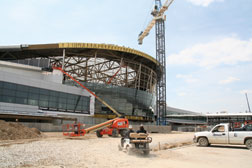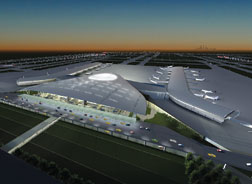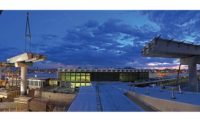 Aviation Capital Management New terminal is surrounded by apron, parking lot, tower and runways.
|
Construction crews working in the crossroads of America have had to juggle a tricky steel-and-glass airport terminal sited in the middle of a two-mile-long, one-mile-wide airfield site that promises to dress up the city into a world-class aviation hub. The program, which is slated to open at the end of next year, also would bring air travelers closer to planes and save airline operators millions of dollars a year on fuel wasted as planes taxi to and from the airport’s existing, 50-year-old terminal.
In addition to connecting people to the airport’s middle ground, the city’s new, $1.1-billion midfield terminal also aims to bring together the best in modern air travel. It will be jeweled with energy-efficient lighting, including a signature 200-ft-diameter glass-and-steel skylight and surrounding curtainwalls glazed in a low-emissive coating. Its exposed, doubly curving roof will be studded with long, tubular steel trusses that are supported by pinned tree columns whose welds will be ground down and painted to a smooth finish. Behind the scenes, the terminal’s guts will be hardened with the latest in security, surveillance and baggage equipment. Finishing up the 30-year-planned project has hit some snags, but crews are moving fast to fly in glass, concrete and steel as construction nears its peak of about 1,500 workers next month.
The project team has had to serve three main masters—security, structure and sustainability—with the new airport’s terminal building at the center of their attention. “This is a totally integrated sort of building,” says Ripley Rasmus, design principal for St. Louis-based master architect Hellmuth, Obata + Kassabaum. “In a building like this, the engineering is the architecture.”
 Aviation Capital Management |
 Tudor Hampton/ENR Tapered columns, pins, require lots of welding and grinding.
|
Life After 9/11
The midfield program, which started becoming defined in 1999, is slated to open a year late (it is on time for its current design) due to program changes after 9/11, such as added space for in-line baggage screening. A four-story main building, with its winglike, 320,000-sq-ft reflective roof, will swoop people and planes closer to the airfield’s three runways and save airlines about 23% on fuel.
The program, which the city is funding through bonds, federal grants and airport revenue, is an ambitious one. “I think it’s a pretty gutsy decision for such a small airport,” says Richard Marchi, a senior policy advisor for Airports Council International’s North American office in Washington, D.C. Indianapolis handles a relatively small 8-million air passengers per year, but Indianapolis, often termed the “Circle City,” likes to look around the bend, and it has been planning the new midfield airport since 1975.
Local officials think the project will poise the city for future growth, too. On the airside, the midfield terminal splits into two, 1,300-ft-long, 100-ft-wide, 30-ft-high concourses, each holding 20 gates and bookending 110 acres of a new concrete runway apron. The owner says it can expand capacity later to 64 gates. When it opens, the airport can combine two international gates to handle Airbus’ forthcoming A380 behemoth airliner.
 Tudor Hampton/ENR Rotunda has 200-ft-diameter skylight, canted glass-and-steel walls.
|
In the middle of the midfield is the program’s main terminal building, whose roof is being decked out with a 200-ft-diameter, curved skylight supported by steel beams and tensioned cable. Its glass will hover 60 ft above a public, pre-security rotunda that can be converted in to a post-security space, if needed. “We had to design this thing so it is completely flexible, limiting what we call ‘hard points,’” says Alan Tucker, project manager for Aero Design Group, the local architect of record, part of an eight-firm joint-venture led by CSO Architects.
In the ticketing areas, an insulated roof peppered with smaller rectangular skylights will draw natural light into a trapezoidal-shaped departure hall framed in 108,000 sq ft of high-performance glass and 8,000 tons of exposed structural steel. Below the big round skylight, a radiant heated and cooled floor will keep passengers cozy and save costs by using less forced air than normally required.
But the hall’s structural complexity, with its cambered, two-directional roof trusses and its exposed, pinned tree columns, have taken the construction team to task. With the curvy roof, which some team members have referred to as a clamshell, wing or potato chip, “there is really nothing straight,” says Tim Hanenburg, president of steel fabricator Cives Corp.’s office in Wolcott, Ind. “So trying to make sure you are hitting the correct elevation, that is the challenge.”
Because the trusses accommodate the roof's 1,260-ft-radius curve, which bends in two directions, the trusses, made of welded, wide-flange upper chords and tubular lower chords, “all merge together to work as a two-dimensional system,” says David McLean, vice president in the Chicago office of Thornton Tomasetti Inc. The truss layout, designed and fabricated using computer modeling, also has redundancies to withstand a blast. “It would sag, but the roof wouldn’t collapse,” McLean explains. The owner retained an independent blast consultant to verify that, but the results were kept top secret from the design consultants.
 HOK Roof curves side-to-side and front-to-back, making fit-up a tough exercise.
|
Shifting Structure
Contractors accidentally gave the roof’s resiliency a test drive when a 110-ft-long, 12-ft-deep truss slipped 16 in. off a shoring tower in January as the roof erector, Ben Hur Construction Co. of St. Louis, was jacking it up to its 80-ft-high elevation. The incident, which did not hurt anyone, caused minor damage to an adjacent truss that was bolted and tack-welded into place, forced the owner to shut down the roof construction for several months. The cause is still under investigation, and costs are still being tallied, but the owner thinks it won’t take a big hit. “We believe that the event is an insured event,” says John J. Kish, project director for the Indianapolis Airport Authority. The owner’s risk policy carries a $100,000 deductible.
The roof is back in business after the erector last month doubled the capacity of two of its custom-made jacking towers to 500 kips and completed the lift. The subcontractor was 80% done when the accident happened, and it is now set to wrap up...

